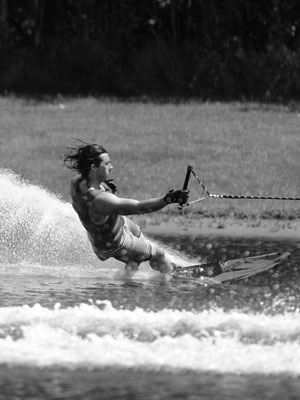

Inside the HO V-Type Water Ski w/ Dave Wingerter
We’re really excited to announce HO’s new slalom ski, the V-type. HO has just launched their first teaser ad for the new ski which looks to be hitting shelves in late August, but we simple couldn’t sit around and wait. We jumped on the phone and called the man, the myth, the legend, Mr. Dave Wingerter, and after much bribery and nagging, we were able to squeeze out the interview below.
So Dave, everyone’s going to ask, so lets start off with it, why did you leave the A series and S series in favor of the new V-TYPE Name - Why is the ski called the V Type?
Dave: "Back in 2010 we came out with the A1, which stands for angle. We had a great run with these skis: The A1, A2, and A3. We had Will Asher tie the world record. Then, we had the S1 and S2, which stood for speed. They ran higher in the water, with really low drag, and a quicker turn shape. We ran both of these series of skis for 5 years. Now, for 2015, we’ve combined the best attributes of what we learned from the angle skis and the best attributes of the speed skis. If you look in your physics text book, speed with direction (or angle) equals velocity, so that’s what we’re essentially doing with the new Velocity Type ski, we’re combining what we’ve learned over the last 5 years and put it into one ski called V-TYPE."
So give us the details, how does the V-TYPE differ from previous skis?
Dave: "The LaPoint brothers, Will Asher, and myself played around with the characteristics and features of the ski a lot. One of the cool features of the V-TYPE is it has a V shape to it. If you stand the ski up against the wall with it’s tail on the ground, you can really see the new "V" Shape. It still has a wide area under the front foot, like an S2, to provide speed, support, and stability, but then behind the front foot it narrows, or tapers, a bit more drastically. We've found time and time again, the narrower the tail is, the easier it is to roll the ski on edge. The easier it is to get on edge, the easier it is to produce angle off the turn and into the wakes."
Tell us about the new rocker? What should we expect with it?
Dave: "We’re calling it Velocity rocker and under the foot it’s got a nice flat spot. It provides a true stable platform for speed and stability. Then, behind the flat spot we’ve increased the rocker in the back half of the ski. The increased tail rocker naturally creates angle off the buoy and angle into the wakes. Skiing the V-Type, you really just need to stand there and the ski will gain angle off the buoy and into the wakes. I was out with Will Asher last night, and when you watch him ski, he stands nice and tall into the turn and then his ski rotates through the turn getting incredible angle, and then generates more angle into the first wake with very little body movement, and that’s our goal with V-TYPE."
Alright one more question, give us some details about your new tuning feature on the tip.
Dave: "Stability Tuning is something we’ve been playing with for a long time and we're finally ready to put it into production on this V-Type water ski. Working with Chris and Bob LaPoint has been awesome as they’ve been around through the years of wood construction to fiberglass to now carbon construction. The move from Fiberglass to Carbon was a big transition as the a carbon water ski is so reactive and snaps back so much quicker making the ski faster off the buoy. Everyone agreed, “This is the future, we need to make skis out of this stuff.” But the downside with carbon is that it reacts too quickly in the front of the ski. It provides too much chatter and noise (or feedback) to the skier, so the ski can actually feel a bit too unstable. We’re now introducing a stainless steel tip weight that sits on a damper pad, and screws right into the nose, or shovel, of the ski. The V-TYPE is the lightest ski we’ve ever made; around 3 lbs. We've found that adding the tip weight to the nose of the ski slows down the oscillation of the tip, or the frequency of the ski, so the ski feels quiet like the chatter isn’t even there. The dampening counter provides an all feel and stability. The weight isn’t real heavy, it’s about 5 ounces, just enough to reduce smaller vibrations. We’ve added a few inserts so you can move it to fine-tune the ski just like you can with your wing."

